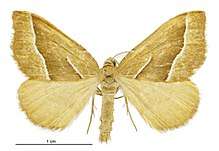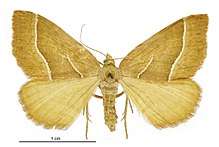Asaphodes stinaria
Asaphodes stinaria is a moth in the family Geometridae. It is endemic to New Zealand. It is classified as Nationally Vulnerable by the Department of Conservation.
| Asaphodes stinaria | |
|---|---|
 | |
| Male | |
 | |
| Female | |
| Scientific classification | |
| Kingdom: | |
| Phylum: | |
| Class: | |
| Order: | |
| Family: | |
| Genus: | |
| Species: | A. stinaria |
| Binomial name | |
| Asaphodes stinaria | |
| Synonyms[3] | |
| |
Taxonomy
A. stinaria was first described by Achille Guenée in 1868 from a specimen collected in Canterbury by Richard William Fereday. Guenée named the species Camptogramma stinaria.[4] The type specimen is held at the Natural History Museum, London.[3] In 1898 George Vernon Hudson subsequently placed this species within the genus Xanthorhoe.[5] In 1971 John S. Dugdale assigned Xanthorhoe stinaria to the genus Asaphodes.[6]
Description
Guenée described the species as follows:
Superior wings ochreous-yellow, suffused with blackish ; the only markings are two distant lines, the first forming a single angle in the cellule, the second simply wavy, these lines are slender, white, narrowly bordered with black on the costa, where they approach nearer one to the other, and followed by a brownish tinge ; extremity of the fringes finely marked with white ; inferior wings ochreous-yellow, without markings above, but beneath they are powdered with red, and traversed by six parallel lines, of which the four first are placed close together and discoidal, the two others isolated and toothed. Body concoloroua, without markings. Antennas of the male furnished with long pubescent and spatulated pectinations.[4]
Distribution
A. stinaria is endemic to New Zealand.[2][7] This species has historically occurred in the following areas but has not been located there recently: Taupo, Hawkes Bay, North Canterbury, Mid Canterbury, South Canterbury, Dunedin and Fiordland. Areas where it has been located recently include Westland, Central Otago, Otago Lakes and Southland.[8]
Ecology and habitat
Adults of the species emerge during the months of November until March with December being the most common month in which the adult moth has been collected.[9] A. stinaria has been found in wetlands,[10] tussock country,[11] open non-forest habitat as well as grassy openings in forested habitat.[9][12]
Host plants
Fereday is recorded to have stated that this species frequented Carex subdola.[13] It is currently thought that A. stinaria is associated with a 'hairy' Ranunculus species.[14] However at present the name of the specific host species is unconfirmed.[8]
Conservation status
This species has considerably reduced its range in recent times. It is regarded as possibly becoming extinct in the eastern parts of New Zealand.[8] The moth has therefore been classified under the New Zealand Threat Classification system as being Nationally Vulnerable.[1] It has been suggested that the decline of this moth is as a result of habitat destruction and the overgrazing of its possible host plant.[11]
References
| Wikimedia Commons has media related to Asaphodes stinaria. |
| Wikispecies has information related to Asaphodes stinaria |
- Hoare, R.J.B.; Dugdale, J.S.; Edwards, E.D.; Gibbs, G.W.; Patrick, B.H.; Hitchmough, R.A.; Rolfe, J.R. (2017). Conservation status of New Zealand butterflies and moths (Lepidoptera), 2015 (PDF). Wellington, New Zealand: New Zealand Department of Conservation. p. 6. ISBN 9781988514383.
- "Asaphodes stinaria (Guenee, 1868)". www.nzor.org.nz. Landcare Research New Zealand Ltd. Retrieved 2018-05-02.
- Dugdale, J. S. (1988). "Lepidoptera - annotated catalogue, and keys to family-group taxa" (PDF). Fauna of New Zealand. 14: 174. Retrieved 1 May 2018.
- Guenée, A. (1868). "New species of heterocerous Lepidoptera from Canterbury, New Zealand collected by Mr. R.W. Fereday". The Entomologist's Monthly Magazine. 5: 92. ISSN 0013-8908 – via Biodiversity Heritage Library.
- Hudson, G. V. (1898). New Zealand moths and butterflies (macro-lepidoptera). London: Newman & Co. p. 60. doi:10.5962/bhl.title.7912.
- Dugdale, J. S. (1971). "Entomology of the Aucklands and other islands south of New Zealand: Lepidoptera, excluding non-crambine Pyralidae". Pacific Insects Monograph. 27: 55–172.
- Gordon, Dennis P., ed. (2010). New Zealand inventory of biodiversity. Volume two. Kingdom animalia : chaetognatha, ecdysozoa, ichnofossils. Vol. 2. Christchurch, N.Z.: Canterbury University Press. p. 459. ISBN 9781877257933. OCLC 973607714.
- Patrick, Brian; Dugdale, John S. (2000). Conservation status of the New Zealand Lepidoptera (PDF). Wellington, New Zealand: Department of Conservation. p. 20. ISBN 0478218672.
- Sherley, Greg (August 1989). Important Conservation research topics on terrestrial arthropod species in New Zealand (PDF). Department of Conservation. Retrieved 2 May 2018.
- Patrick, Brian (2014). "Ecology and conservation of the rare moth Asaphodes frivola Meyrick". Weta. 47: 17–38.
- Pawson, Stephen M.; Emberson, Rowan M. (2000). "The conservation status of invertebrates in Canterbury". hdl:10182/1658. ISSN 1171-9834. Cite journal requires
|journal=(help) - Watts, C. (2016). "Invertebrate services within Cape to City and comparison of environmental DNA with conventional invertebrate community monitoring: Research Synthesis 2015/2016" (PDF). Landcare Research New Zealand Ltd. Retrieved 13 May 2018.
- Meyrick, Edward (1884). "A Monograph of the New Zealand Geometrina". Transactions and Proceedings of the New Zealand Institute. 16: 49–113. Retrieved 2 May 2018.
- Mt Aspiring Station Conservation Resources Report Part 1 (Report). Department of Conservation. November 2005. pp. 1–62. Retrieved 2 May 2018.
